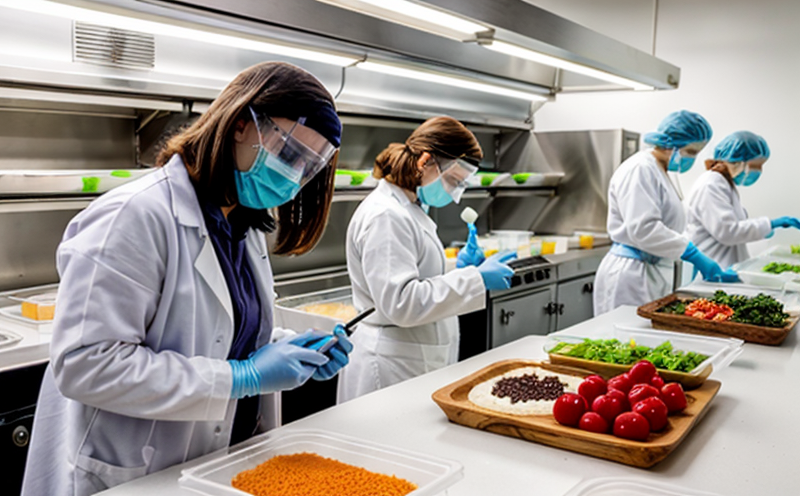AOAC 2003.01 Listeria monocytogenes Detection Testing
The AOAC International standard method 2003.01 is a widely recognized and trusted protocol for detecting Listeria monocytogenes in food samples. This stringent testing ensures that food products meet the highest safety standards, protecting consumers from potential health risks associated with this pathogen.
Listeria monocytogenes is a Gram-positive, facultative anaerobe bacterium capable of causing listeriosis, an infectious disease that can be particularly dangerous for pregnant women, newborns, older adults, and those with weakened immune systems. The ability to detect Listeria early in the production process is critical in preventing contamination in food products.
The AOAC 2003.01 method employs a combination of enrichment broth (Tryptic Soy Broth) followed by a series of biochemical tests, including the use of specific antibodies and reagents that target antigens unique to Listeria monocytogenes. This multi-step process ensures accurate and reliable detection.
The testing procedure begins with the collection of samples from various food matrices such as ready-to-eat meats, dairy products, and processed foods. Samples are then inoculated into Tryptic Soy Broth (TSB) and incubated at 35°C for 24 hours. Positive cultures are further tested using a combination of biochemical reactions and immunological tests to confirm the presence of Listeria monocytogenes.
The method is highly sensitive, capable of detecting as few as 10 CFU/mL in some conditions, making it an essential tool for food safety professionals. However, it is important to note that false positives can occur if not conducted under strict laboratory conditions and with proper calibration of equipment.
Adherence to the AOAC 2003.01 protocol ensures consistency and reliability in testing results. This method is frequently used by regulatory bodies worldwide to enforce food safety standards and guidelines such as those outlined in FDA's Hazard Analysis and Critical Control Points (HACCP) system.
| Step | Description |
|---|---|
| Sample Collection | Careful selection and preparation of samples from various food matrices. |
| Inoculation | Inoculating samples into Tryptic Soy Broth (TSB) for 24 hours at 35°C. |
| Enrichment | Selective enrichment to increase the concentration of Listeria monocytogenes. |
| Incubation | Further incubation and testing for biochemical reactions and immunological tests. |
Quality and Reliability Assurance
The AOAC International method has been validated through rigorous scientific research and is recognized as a reliable standard for detecting Listeria monocytogenes. Laboratories that perform this testing ensure compliance with international standards such as ISO/IEC 17025, which mandates strict quality management systems.
Our laboratory adheres to these stringent requirements, ensuring that every test conducted meets the highest level of accuracy and precision. Our team of trained professionals uses state-of-the-art equipment calibrated according to international guidelines to ensure consistent results across all tests.
We also participate in proficiency testing programs organized by regulatory bodies such as AOAC International and FDA to validate our methods and continuously improve our processes. This commitment to quality is reflected in our consistently high pass rates in these programs, which are open for review upon request from clients.
Environmental and Sustainability Contributions
The detection of Listeria monocytogenes plays a crucial role in environmental health by preventing contamination that can lead to foodborne illnesses. By ensuring the safety of our food supply, we contribute directly to public health.
Our laboratory’s operations are also environmentally responsible, adhering to ISO 14001:2015 environmental management systems. This ensures that we minimize waste and energy consumption in our facilities while maintaining high standards of testing.
We actively participate in sustainability initiatives aimed at reducing the carbon footprint associated with laboratory operations. By optimizing our processes, we contribute to a more sustainable future, aligning with global goals for environmental protection.
Use Cases and Application Examples
- Regulatory Compliance: Ensuring compliance with FDA's HACCP guidelines by detecting Listeria in food products.
- R&D Support: Identifying potential sources of contamination during product development to enhance safety measures.
- Quality Control: Monitoring production processes for Listeria presence to maintain consistent product quality.
- Supply Chain Assurance: Providing third-party testing services to ensure the safety and integrity of food products throughout the supply chain.
| Application | Description |
|---|---|
| Ready-to-eat meats | Detecting Listeria in products such as deli meats, sausages, and pâtés. |
| Dairy Products | Testing for Listeria in cheese, yogurt, and other dairy-based foods. |
| Processed Foods | Monitoring for contamination in products like soups, sauces, and meal kits. |





